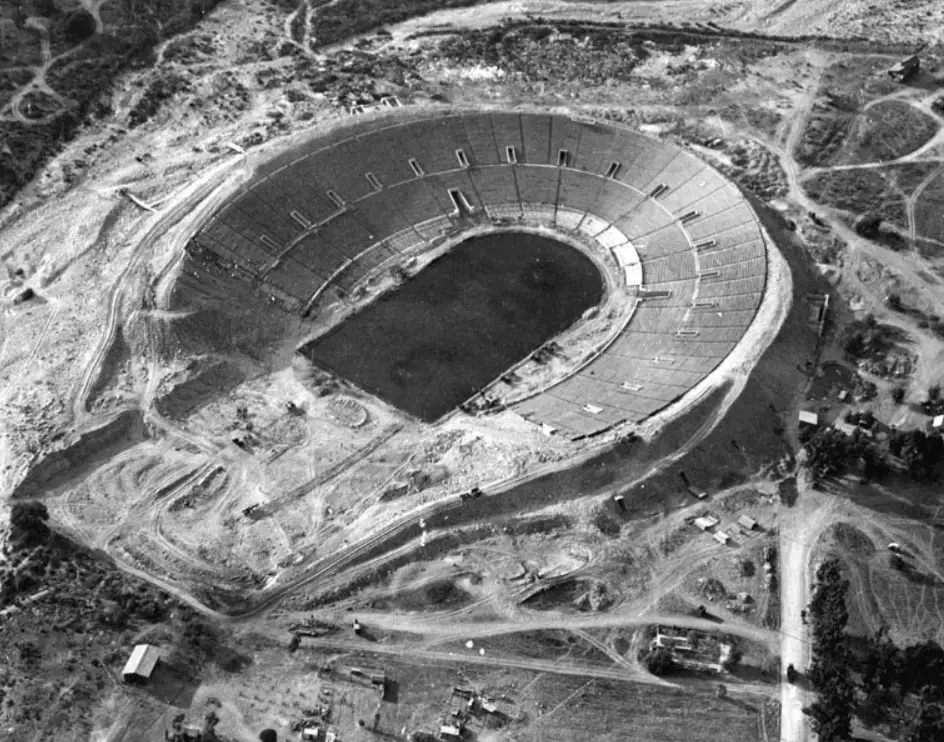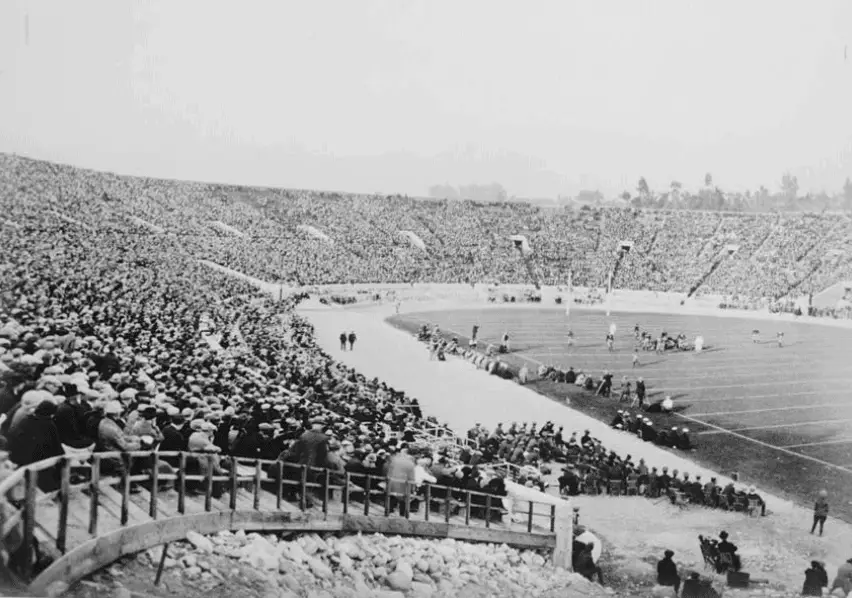This is one of the most iconic stadiums in the United States, the biggest stadium in California, and one of the largest stadiums in the US as well.
In this post, you’ll discover the ultimate list of facts about the history of the Rose Bowl Stadium.
1. It’s located in Pasadena, California
The Rose Bowl is located in the city of Pasadena in Los Angeles County. The city is located just 11 miles (18 kilometers) to the northeast of Downtown Los Angeles
The Rose Bowl Stadium is located at the edge of a residential neighborhood in the western part of the city.

2. The Rose Bowl was named after a special annual game
The first Rose Bowl game was played in the year 1902 and has been an annual tradition since 1916. The stadium was built just a few decades after the first game was played and was named after it.
Back in 1902, the game was known as the “Tournament East-West football game.”

3. The original Rose Bowl was played just 3 miles away
One of the most interesting facts about the history of the Rose Bowl is that the games played before 1923 were played just 3 miles (4.8 kilometers) away, in a stadium referred to as “Tournament Park.”
This stadium is currently a park and athletics venue but was originally used for football games and even chariot racing as well!

4. The stadium was built because the crowd rose to over 40,000 people
As you can see from the image above, the stands were pretty awful and as the Rose Bowl grew in popularity, it quickly outgrew the number of visitors that Tournament Park could accommodate.
This means that the main reason that the Rose Bowl Stadium was built was to host the annual Rose Bowl Game and welcome a lot more spectators.
5. The Rose Bowl was designed by a renowned architect
The stadium’s main architect was Myron Hunt (1868-1952), one of the most renowned architects in California at the time who worked on numerous landmarks in the area.
He was already elected a Fellow in the American Institute of Architects back in 1908, 14 years before the Rose Bowl Stadium was constructed!

6. The inspiration for its design came from a stadium in Connecticut
Hunt didn’t create an original design with the Rose Bowl Stadium as he was inspired by another stadium located on the other side of the country, in New Haven, Connecticut.
This stadium is named the “Yale Bowl” and as you can see, it really resembles the Rose Bowl Stadium.

7. Construction of the Rose Bowl took just 8 months
One of the most remarkable facts about the history of the Rose Bowl Stadium is that it only took 8 months to build this massive stadium.
The design was completed by Hunt in 1921 and construction started on February 27, 1922. Just 8 months later in October of the same year, the stadium was completed, at an incredible pace!
This is one of the reasons why the stadium has been recognized as a National Historic Landmark in the United States, and as a California Historic Civil Engineering landmark as well.
8. The original shape of the stadium was that of a horseshoe
Another one of those interesting facts about the history of the Rose Bowl Stadium is that the original design of the stadium wasn’t completely round, but that of a horseshoe.
The stands in the south of the stadium were built 6 years after the stadium was completed in 1928, which meant the stadium was completely enclosed into a bowl since then.

9. The first official game was played on October 28, 1922
Imagine that construction only started on February 27, 1922, and that the first official game was played about 8 months later on October 28, 1922.
It actually happened!
On that day, the California Golden Bears beat the USC Trojans with 12-0 in the first official game at the Rose Bowl Stadium.
Even though California ended the season undefeated and USC suffered their only defeat in that game, USC played the first Rose Bowl against Penn State and won 14-3 on January 1, 1923!

10. Another famous stadium in the area was completed shortly after
Another famous stadium in the area is called the “Los Angeles Memorial Coliseum” and was completed shortly after the Rose Bowl Stadium was completed in 1923. after all, these were the “Roaring Twenties!”
This stadium has hosted the Summer Olympics 2 times in 1932 and 1984 and will become the first stadium in the world to have hosted the Olympic Games 3 times as it will serve as a venue during the 2028 Summer Olympics as well.
The Rose Bowl Stadium was the track cycling venue for the 1932 Summer Olympics.

11. The Rose Bowl originally had some different names
Back in 1922, shortly after the stadium was completed, an official name hadn’t yet been determined. Some names that were going around were “Tournament of Roses Stadium” and “Tournament of Roses Bowl.”
One of the main reasons that the stadium was eventually officially named the “Rose Bowl” is that its design resembled that of the “Yale Bowl.” This combined with the main reason it was built, to host the annual Rose Bowl, made them settle on the “Rose Bowl.”
12. They forgot one crucial element when constructing the stadium
Have you ever been to a game at the Rose Bowl? If not, let me tell you this, if you’re coming in your car, you better go there well in advance!
The reason is that they didn’t think of the fact that a lot of people coming to the stadium will bring their car with them (or vice versa), so there needs to be a lot of parking space.
Unfortunately, the stadium is located in between a residential neighborhood and a golf course, without a decent parking lot.
The result?
People sometimes having to walk for over a mile to reach the stadium!

13. It was the largest stadium in the United States for many years
The stadium was expanded several times and had its maximum capacity between 1972 and 1998. In this period, it had a seating capacity of 104,091, which made it the largest stadium in the United States for multiple decades.
It was only surpassed by Michigan Stadium in 1998 which had a total seating capacity of 107,501 back then (now 107,601). This makes it the largest stadium in the country and the third-largest stadium in the world behind the Rungrado 1st of May Stadium and the Motera Stadium.
14. The stadium lost over 11,000 of its seats in 1998
Even though the official capacity of the Rose Bowl Stadium was 104,091 until 1998, in reality, this number was much lower. The reason for this was the fact that the lowest rows of the stadium weren’t used and even covered with billboards.
Ever since 1998, the stadium capacity has been revised and the official seating capacity is now 92,542.

15. The names of MVP’s and coaches are added to the stadium’s south wall
The southern end of the stadium features the “Court of Champions,” a wall with plaques commemorating all the MVPs and coaches of the Rose Bowl Games in the past.
In front of this wall, there’s also a statue of Brandi Chastain, the captain of the female United States soccer team who won the 1999 FIFA World Cup!

16. The stadium is managed by a non-profit organization
The city of Pasadena owns the stadium and it’s managed by a non-profit organization called the “Rose Bowl Operating Company.” This organization also managed the adjacent Brookside Golf and Country Club.
The board members of this non-profit organization are selected by the council of the city of Pasadena.
17. It has hosted numerous famous events, and more to come in the future!
Apart from hosting the annual Rose Bowl Game and 5 Super Bowls, which is the second-most of any venue, the Rose Bowl has also hosted numerous important soccer games.
Some of the most notable include:
- 1994 FIFA World Cup Final
- 1999 FIFA Women’s World Cup Final
- 1984 Olympic Gold Medal Match
- CONCACAF and United States Soccer Federation matches
Apart from soccer games, the stadium has been the venue of numerous concerts by some of the world’s most popular artists and the site of the famous 4th of July fireworks display in Pasadena!













